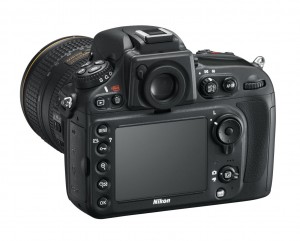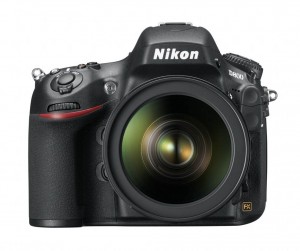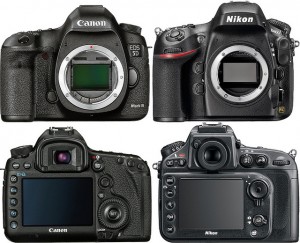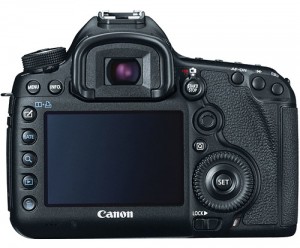Canon 5D Mark III and Nikon D800 Pro DSLR Comparison – Which one Is Better?
Are you a die hard Canon user or a dyed in the wool Nikon fan? There are some biased photographers that swear by their favored brand and claim to be un-compromised when it comes to their beloved camera brand they have used since first being bitten by the photography bug. It may be that most brand snobs don’t realized that it can come across as snobbish (and insulting) when they respond with “I only use Nikon I’d NEVER use Canon” when asked what brand of camera they use.
But is there really a significant difference that makes one brand better than the other? Or is it all a matter of taste? Both Nikon and Canon companies are based out of Japan have been rated as #1 in camera sales over the years, they both have produced high quality equipment and are backed up with quality assurance and excellent warranties. Their range in styles are DSLR to compact point and shoot. Whether your a novice who just wants the simple camera for the occasional family vacation or birthday party, or a professional veteran photographer whose lively hood depends on his/her gear, each of these industry leaders can provide the right camera for your purpose.
Since both are used by leading award winning photographers around the world saying one is better than the other is just really a matter of preference. It all depends on tastes and what features you can’t live without.
Megapixels
Nikon D800 DSLR offers an impressive 36 megapixel sensor, while the Canon EOS 5d mark III offers a mere 22 megapixel that’s a 14 megapixel difference for a camera that’s costs is about the same.
Video
More photographers are wanting their DSLR to have a high definition video feature. And it’s pretty impressive that some of the latest action packed block buster movies were recently made using the Canon 5d Mark II. Nikon’s D800 is no slacker, it’s been used for TV broadcasting in serval studios from TV shows to nightly news. Both of these camera systems have models that offer full HD recording with range of frame rates, available headphone audio monitoring & stereo sound recording, manual controls for exposure, that are capable of high quality high-definition footage, pretty impressive. However, Canon first came up with a excellent focus tracking system, its Duel Pixel CMOS AF used with STM lenses that’s been designed for video, the autofocus is smooth, fast and an accurate.
Body Style
The design and placement of dials, controls, flip screens and shutter release buttons differ from Canon and Nikon, they’re almost always opposite. For example, Canon places their quick control dial at the rear of its camera while Nikon has two dials one in front and one in the back of its grip and a D-pad on the rear of its camera. When it comes to zooming and focusing, exposure, and mounting the lens, they’re at opposite ends. So as to why most photographers have a biased camera brand when it comes to handling, it’s no wonder that why there’s a favored brand, if one were to switch back and forth between the two models (in one photo shoot for example), it’d be a recipe for frustration and disaster. However, that being said, there are professionals that carry both and are used to switching back and forth, but with novice or hobby photographers it can be frustrating at best. When it comes to body styles and placements of knobs, dials and controls this is all a matter of tastes, one is not better that the other, so it’s just a matter of personal opinion and preference which is better than the other.
Flash Options
For years Nikon has had some kind of secret they’ve patented to ensure perfect and consistent flash exposure, while Canon users struggle with the variation of frame to frame exposure. Just recently Canon’s 5D Mark III has perfected this flash exposure issue and is now equal to Nikon’s. The only draw back is Nikon still out performs Canon by way of user friendly flash settings. While Nikon has easy to find and select options, Canon requires some research and thorough reading of their manual to find how to change settings like flash sync and speed.
Hybrid Autofocus
Most DSLR cameras have two distinct types of autofocus speeds, a slow contrast detection or a fast phase detection. The fast autofocus is best used for shooting through the viewfinder, while the slow autofocus is generally best for live view autofocus. Each of these systems are different and non-compatible, until Canon created an advanced system, its 70D features a Duel Pixel CMOS AF than enables an 80% of the sensor area to be used as phase detection so you can switch seamlessly from video to picture. It makes a great camera for film use. Unfortunately Nikon’s hybrid AF system is limited to Nikon series 1 in their compact system.
T ouchscreen
ouchscreen
Canon and Nikon now both carry a vari-angle or tilt and swivel, monitor, but Canon offers a touchscreen and a vari-angle monitor the EOS 60D followed by EOS 600D and 70D, 100D and 700D. Nikon does not have this double feature for the monitors for their DSLR cameras.
LCD
While Nikon and Canon have the same screen dimensions, their ratios differ, Canon has a 3:2, the same as it actual images, while Nikon’s differs so image appears smaller on screen. Canon also has a very specific coating on it’s screen that resists oil smudging from fingers while Nikon doesn’t. The materials the screens are made from also different, Canon has a high-quality screen that’s anti-refection and easy to view in daylight, Nikon remains uncoated and difficult to view in outdoor light.
Data Embedding
Nikon has more advanced features that lets you embed your images without having to upload to a computer first. Canon has just caught up with Nikon on this, where as before one would have to load the images and use special software to embed images on their PC.
Uploading
Nikon offers easy data transferring without any software to install, folders can be created within the camera settings itself for easier transferring too. Canon still requires special software you must install in your PC before you can transfer your images.
While there are other features where one is better than the other it’s always best to talk to a professional and ask why they prefer their favored brand. There is always a trade off and if you’re on a tight budget it’s best to try out each before you decide on which you’ll be investing in. If you offer to do an internship with a professional, you can get hands on experience and an insight to the differing features to these two amazing camera systems. You may find that a Nikon fits better in your hands, or you may discover a you favor Canon’s LCD touch-screens, but the only sad part is, as stated before is deciding what your trade-off is going to be. Happy shooting!






